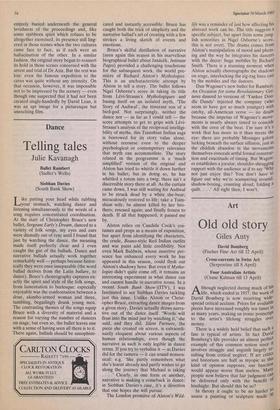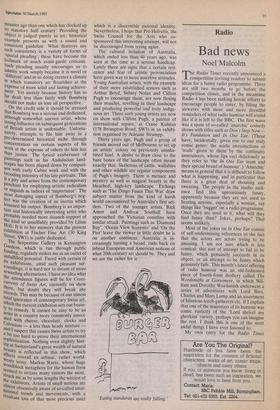Art
Old old story
Giles Auty
David Bomberg (Fischer Fine Art till 12 April) Four Australian Artists (Crane Kalman till 13 April) A 'though neglected during much of his which ended in 1957, the work of David Bomberg is now receiving wide' spread critical acclaim. Prices for available pieces have increased roughly ten times.at as many years, making an ironic postscript to the artist's lifelong struggles over money. There is a widely held belief that such. fate is typical of artists. In fact David Bomberg's life provides an almost perfect example of this common notion since it involves struggle and anguish largely r.e" suiting from critical neglect. If art critics. and historians are half as myopic as this kind of opinion supposes, our function would appear worse than useless. ManY people now believe that fair judgment cat! be delivered only with the benefit 01 hindsight. But should this be so? In theory it ought to be no harder tt),, assess a painting or sculpture made 5" minutes ago than one which has clocked up its statutory half century. Providing the Object is judged purely as art, historical example presents us with a sound and consistent guideline. What destroys any such consistency is a variety of forms of Special pleading'; these have become the hallmark of much avant-garde criticism. Such pleading usually encourages us to admire work simply because it is novel or .different' and in so doing creates a climate in which transitory art flourishes at the expense of more solid and lasting achieve- ment. Yet merely because history has so far dealt less than fairly with Bomberg Should not make us lose all perspective. On the credit side it should be stressed that Bomberg was a serious and dedicated, although somewhat uneven artist, whose strong influence on subsequent generations of British artists is undeniable. Unfortu- nately, attempts to file him away in a pre-determined historical niche through concentration on certain aspects of his work at the expense of others do him less than justice. The lyrical exuberance of Paintings such as his Andalucian land- scapes has been played down by compari- son with early Cubist work and with the brooding intensity of his late portraits. This is a pity and arises from the contemporary Penchant for employing artistic radicalism or anguish as indices of 'importance'. The most damaging aspect of Bomberg's neg- lect was the creation of an inertia which lessened his output. Bomberg is an impor- tant and historically interesting artist who Probably needed more staunch support of the kind so unselfishly provided by Lilian Holt. It is to her memory that the present exhibition at Fischer Fine Art (30 King Street, sw is justly dedicated. The Serpentine Gallery in Kensington Gardens, which is run through public funding, regularly strikes me as an outlet of u. nfulfilled potential. Faced with certain of its exhibitions, amid such pleasant sur- roundings, it is hard not to dream of more rewarding alternatives. I have no idea what the attendance figures will be for Cross- currents of Swiss Art, currently on show There, but doubt they will break any records. This may be because of our almost total ignorance of contemporary Swiss art, 'Inch the current exhibition sets out brave- IY to remedy. It cannot be easy to be an artist in a country more commonly associ- ated . with cheese, chocolate, clocks and Calvinism — a less than heady mixture — and I suspect this causes Swiss artists to try a bli.too hard to prove their international s. oPhistication. Nothing even slightly hint- ing at Switzerland's great wealth of natural oeauty is reflected in this show, which affects overall an urbane, rather world- Weary irony. Markus Raetz, whose huge woodblock metaphors for the human form seemed to irritate many visitors the most, tsktruck me as by some lengths the wittiest of ", e exhibitors. Artists of small nations are aiMost obsessively aware of so-called inter- rational trends and movements, with a esultant loss of that most precious asset which is a discernible national identity. Nevertheless, I hope that Pro Helvetia, the Swiss Council for the Arts who co- sponsored this interesting attempt, will not be discouraged from trying again. The cultural isolation of Australia, which ended less than 40 years ago, was seen at the time as a serious handicap. Lately there are signs that a certain reti- cence and fear of artistic provincialism have given way to more assertive attitudes. Young Australian artists, with the example of their more established seniors such as Arthur Boyd, Sidney Nolan and Clifton Pugh to encourage them, are now flexing their muscles, revelling in their landscape and producing powerful and truly indige- nous art. Three such young artists are now on show with Clifton Pugh, a painter of international repute, at Crane Kalman (178 Brompton Road, SW3) in an exhibi- tion organised by Adriane Strampp. Thirty years ago, Pugh and a group of friends moved out of Melbourne to set up an artists' colony on previously uninha- bited land. A desire to draw .close to the bare bones of the landscape often meant exactly that. Skeletons of cattle, wallabies and other wildlife are regular components of Pugh's imagery. There is menace and mystery as well as magical beauty in the bleached, high-key landscape. Etchings such as 'The Dingo Fence That Was' draw subject matter from the kind of harsh world encountered by Australia's first set- tlers. Two of the younger artists, Rick Amor and Andrew Southall have approached the Victorian coastline with similar attack. Paintings such as 'Diamond Bay', 'Ocean View Sorrento' and 'On the Pier' leave the viewer in little doubt he is on another continent. Australia is in- creasingly turning a broad, rude back on inbred European and American notions of what 20th-century art should be. They and we are the richer for it.
'Eating standards are really falling.'















































 Previous page
Previous page